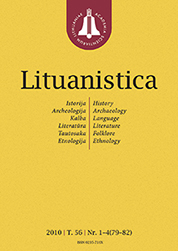LituanisticaWHAT?
 ISSN 0235-716X |
2005 m. Nr. 4 Voluinietiškos Lietuvos užsienio politikos krypties formavimasis (iki Mindaugo mirties 1263 m.)
Before the Lithuanian state came into being, the war leaders of Lithuanian warbands, who were primarily bent on booty, were in no position to form a more sophisticated policy other than that which is characteristic of the so-called policy of warbands, a form of policy-making that must be regarded as a starting point for Lithuanian foreign policy. The Rus’ian dukes who employed Lithuanian warbands to solve their internal problems were eager to manipulate them. That is why the political actions on the part of Lithuanians could be dictated by political considerations of foreign origin. Nevertheless, some of Ru s’ian political actors were instrumental in bringing the newly-emerging Lithuanian ruling dynasty closer to the political scene of East-Central Europe. This role was played most actively by the dukes of Halich-Volhynia.
The Baltic tribe of Yatvingians must be regarded as a stepping-stone that gave Lithuanians an access to Volhynia for their raids of booty. Quite soon, already in 1219, the energetic duke Daniil Romanovich of Halich-Volhynia provided them with looting opportunities and thus engaged them for serving his political needs. His relationship with the strongest Lithuanian princely family and, later, with the monarch Mindaugas was the most important factor in forming the principles of Lithuanian state’s political activities in southern direction. Both of those political partners solved a common problem of how to consolidate their power in their respective realms. The relationship between Mindaugas and Daniil came under pressure and became colder in the wake of Lithuanian occupation of the Rus’ian towns in the upper reaches of the Nemunas (Niemen) river (Nowogrudok, Slonim, Valkavyk, Zdzitav, and, perhaps, Grodno). The tension was not abated even when there was a common interest of subjugating the Yatvingians, an action pursued since 1248. After a while Daniil started openly to strive to oust Mindaugas from power by taking sides with some of Mindaugas’s relatives in their mutual struggle. During the course of the internal war of 1249–1254 Mindaugas was able to safeguard and consolidate his power, but at the same time he was forced to make some territorial and political concessions to his neighbours. According to the tremty of 1254 Mindaugas disclamed some territories in favour of Daniil, allowed his most bitter enemy Tautvilas to take abode in Polock (a dukedom under Lithuanian control), and reneged on his plans in regard of Yatvingians; he even stepped back from this latter scene. The common onslaught of Tatars led by Burunday and the troops of Halich-Volhynia on Lithuania and the land of Nalšia in 1259 brought to an end the political system that was conceived after the 1254 treaty. Mindaugas started to change his political strategy by resuming a new conflict with Halich-Volhynia and by coming to friendly terms with the land of Novgorod which was related to the Grand Duchy of Vladimir-Suzdal’ under the powerful duke Aleksandr Nevsky. |
Numeriai:
2011 - T.57 Nr.1, Nr.2, Nr.3, Nr.4 2010 - T.56 Nr.1-4 2009 - T.55 Nr.1-2, Nr.3-4 2008 - T.54 Nr.1, Nr.2, Nr.3, Nr.4 2007 - T.53 Nr.1, Nr.2, Nr.3, Nr.4 2006 Nr.1, Nr.2, Nr.3, Nr.4 2005 Nr.1, Nr.2, Nr.3, Nr.4 2004 Nr.1, Nr.2, Nr.3, Nr.4 2003 Nr.1, Nr.2, Nr.3, Nr.4 2002 Nr.1, Nr.2, Nr.3, Nr.4 2001 Nr.1, Nr.2, Nr.3, Nr.4 |